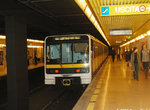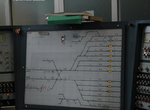Milan, Italy Metro
![]()
Milan metro line M1 at Cordusio. Photo by Peter Ehrlich, March 2009.
Overview
M1. The Red Line (Linea Rossa) is Milan's first subway route, and, like all of Milan's Metropolitana lines, has been opened in stages. The first section of route M1 was opened in 1964, connecting Sesto Marelli in northeast Milan with Lotto, in the western part of the city. In 1966 a branch from intermediate station Pagano to Gambara was added to the main line, giving the Red Line two routes. By 1975, both west legs were extended from Lotto to QT8 and from Gambara to Inganni. In 1986 the main line was extended northward with a suburban extension to Sesto I Maggio FS (shown as "Sesto FS" on front-end destination signs) and westward to Molino Dorino. Finally in 1992 the station Bisceglie was added to the southwestern branch. Currently, an extension of the Molino Dorino branch to the suburbs of Pero and Rho is under construction. An interurban link between Sesto and Monza is in the planning stage (which, ironically, would bring electric rail transport back to Monza, which had been abandoned many years ago).
The voltage of line M1 is 750v and it is the only Metropolitana route operated entirely with third rail. All of the Red Line is in subway. There are two train yards and shops: Precotto and Gallaratese (also know as Molino Dorino). 9 groups of subway cars, consisting of motors, trailers and non-driving motors, were received between 1962 and 1988. Some of the trailers were subsequently converted to non-driving motors.
Standard makeup of trains is a six-car train consisting of two sets of 3-car trains, configured either M-T-M or M-NDM-M. This is standard practice on all Metropolitana routes. During off hours, three-car trains are utilized.
M2. The Green Line (Linea Verde) was opened in 1969 as a short route from Caiazzo -- Cascina Gobba in northeast Milan. It was soon extended westward to Centrale FS (1970) and Garibaldi FS (1971). On December 3, 1972 M2 absorbed the Linee Celeri dell'Adda (i.e. High Speed Adda Lines), an interurban light rail service that had linked Milano with Gorgonzola since May 5, 1968. (The displaced interurbans from this system are still in use today on the Désio and Limbiate interurban routes.)
In 1978 the section Garibaldi FS -- Cadorna FNM was opened on the west end. On June 7, 1981 another interurban section was added from Cascina Gobba to Cologno Nord, replacing the interurban tramway Milano -- Vimercate. In 1983 the urban section of M2 reached Porta Genova FS and in 1985, Romolo. Later in 1985 the interurban section to Gorgonzola was extended two stations further eastward to Gessate. Finally in 1994 the new Romolo -- Famagosta section was opened, and a further one-station extension to Abbiategrasso began operation on March 15, 2005. A short suburban branch from Famagosta to Assago is under construction.
Green Line trains operate on 1500v with overhead wire current collection. The urban section from Abbiategrasso to Udine is in underground, while the eastern sections from Cimiano to Gessate and Cologno Nord, as well the depots, are in open air, on elevated or in open cut--the only Metropolitana route so configured. The Green Line has three depots: Gorgonzola (a former interurban tram depot), Cologno Nord and Famagosta. Rolling stock dates from 1968 through 1994.
People Mover. The San Raffaele People Mover is a short horizontal funicular railway which operates between the Cascina Gobba M2 Station and Ospedale San Raffaele. It is comprised of a single 2-car rubber-tired trainset which shuttles betwen the M2 and the hospital. Although operated by ATM, its fare is not integrated with the regular system fare structure, requiring buying a separate ticket. It opened around 1998.
M3. The Yellow Line, or Linea Gialla, is the newest line of the system. It was opened in 1990 from Centrale FS to Duomo and then to Porta Romana. A year later the route was extended on both ends north to Sondrio and southeast to San Donato. In 1995 another short section was added to the north end, from Sondrio to Zara. The section Zara -- Comasina is now under construction, with the first stretch to Maciachini inaugurated on December 8, 2003 (at the same time as the Metrotramvia Nord tramway). Basically, line M3 runs down the spine of Milan between Centrale FS and Duomo before curving southeastward.
The voltage is 1500v, with catenary and pantograph current collection. All of the Yellow Line is underground with the exception of Deposito San Donato, the only depot. All Line M3 rolling stock--with a newer, more stylish end section than the wrap-around windows found on M1/M2 stock--was built in 1990.
General Service Information. Service on all Metropolitana routes is from 6:00 am to just after midnight. Fare control is by prepaid ticket, which will validate a fresh ticket, and a station agent monitors passes and the station paid areas via closed-circuit TV. Service during the peak hours is as frequent as every three minutes. Except for "uno giorno" and "due giorni" (1 and 2-day tickets), tickets validated on trams or buses are not acceptable for transfer to the Metropolitana. The day passes, valid on everything ATM runs (except interurbans), and includes the "R" (regional railways operating in tunnel within Milan) can be purchased at Duomo (M1/M3),
Centrale FS (M2/M3), and Cadorna FNM (M1/M2) stations.
2009 updates. Over the last couple of years, there has been some modernization of the fleet on the M1 (Red) line, and to a lesser extent, the M2, with selected 3-car trainsets being rebuilt with pass-through rubber communicating modules between cars, brighter lighting, and new plug doors. And in March 2009, the first brand-new train for Line M1 entered revenue service. Some of the older M1 stock has also received air-conditioning, as have all of the rebuilt cars.
A 2-station south extension of Line M2 (Green) from Abbiategrasso is planned for opening in 2009, and a 4-station northwest extension of Line M3 (Yellow) From Maciachini (incidentally, connecting with the Limbiate Interurban at Affori) and the new line M5 from Stazione Garibaldi to Bignami are planned for opening in 2011. The M5 will be dubbed the Purple Line.
Photo Gallery
| Five Random Images | ||||
 Image 12060 (146k, 720x478) Photo by: Peter Ehrlich Location: Lodi TIBB F.S. |  Image 52420 (142k, 864x574) Photo by: Peter Ehrlich Location: Gorgonzola Depot |  Image 52424 (185k, 864x574) Photo by: Peter Ehrlich Location: Cascina Gobba |  Image 99437 (194k, 930x618) Photo by: Peter Ehrlich Location: Loreto |  Image 104967 (197k, 1044x706) Photo by: Richard Panse Location: Precotto |
Page Credits
By Peter Ehrlich.